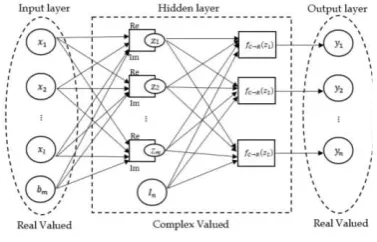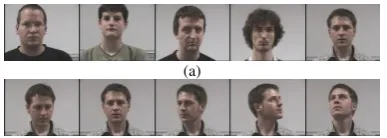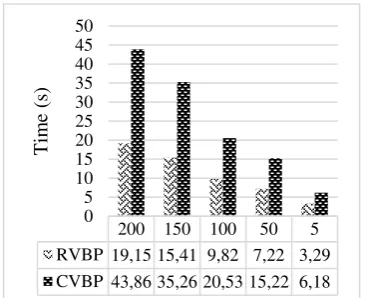103
FACE RECOGNITION USING COMPLEX VALUED BACKPROPAGATION
Z Nafisah
1, Muhammad Febrian Rachmadi
2, and E M Imah
1*1
Mathematics Department, Faculty of Mathematics and Natural Sciences, Universitas Negeri Surabaya
Jl. Ketintang, Surabaya, 60231, Indonesia
2
School of Informatics, The University of Edinburgh, 11 Crichton Street, Edinburgh EH8 9LE, United
Kingdom
*E-mail: [email protected]
Abstract
Face recognition is one of biometrical research area that is still interesting. This study
discusses the Complex-Valued Backpropagation algorithm for face recognition.
Complex-Valued Backpropagation is an algorithm modified from Real-Valued
Backpropagation algorithm where the weights and activation functions used are complex.
The dataset used in this study consist of 250 images that is classified in 5 classes. The
performance of face recognition using Complex-Valued Backpropagation is also
compared with Real-Valued Backpropagation algorithm. Experimental results have
shown that Complex-Valued Backpropagation accuracy is better than Real-Valued
Backpropagation.
Keywords: Face Recognition, Complex Valued Backpropagation
Abstrak
Pengenalan wajah seseorang merupakan salah satu riset di bidang biometrika yang masih
sangat menarik hingga saat ini. Dalam penelitian ini membahas algoritma
Complex
Valued Backpropagation untuk pengenalan wajah.
Complex Valued Backpropagation
merupakan algoritma yang dikembangkan dari algoritma
Real Valued Backpropagation
dimana bobot dan fungsi aktivasi yang digunakan bernilai kompleks. Dataset yang
digunakan berjumlah 250 citra wajah yang diklasifikasikan kedalam 5 kelas. Performa
hasil pengenalan wajah menggunakan
Complex Valued backpropagation juga
dibandingkan dengan algoritma
Real Valued Backpropagation. Hasil eksperimen yang
telah dilakukan menunjukkan bahwa akurasi Complex Valued Backpropagation lebih baik
dibandingkan dengan Real Valued Backpropagation.
Kata Kunci: Pengenalan Wajah, Complex Valued Backpropagation
1.
Introduction
Face recognition is one of the biometrical research.
Until todays face recognition still interesting and
challenging research area. Face recognition
already using in many applications such as
security sys-tems, credit card verification,
criminal identifi-cation etc. Recently, there are
many methods and algorithms that is used for face
recognition such as Chittora et al using support
vector machine [1], Kathirvalavakumar et al using
Wavelet Packet Coefficients and RBF network [2],
Cho et al using PCA and GABOR wavelets [3],
Sharma using PCA and SVM [4]. Almost all those
authors studying face recognition using Real
Valued Machine Learning.
advantages in reducing the number of parameters
and operations involved. In addtion, CVNN has
computational advantages over real valued neural
networks in solving classification problems [6].
Several literatures was use CVNN such as: A
Novel Diagnosis System for Parkinson’s Disease
Using Complex-Valued Artificial Neural Network
with
k-Means
Clustering
Feature
[7],
Fluorescence Microscopy Images Recognition
using Complex CNN [8], A New Automatic
Method of Parkinson Disease Identification Using
Complex-Valued Neural Network [9], Automatic
Sleep Stage Classification of Single-Channel EEG
by Using Complex-Valued Convolutional Neural
Network [10].
One of the learning processes that utilizes
Complex valued neural network is Complex
Valued backpropagation (CVBP). CVBP is an
algorithm developed from Real Valued
Backpro-pagation algorithm where the weights and
acti-vation functions used are complex. According to
research conducted by Zimmerman, the average
learning speed of the CVBP algorithm is better
than the Real Valued backpropagation (RVBP)
[11]. Based on that literature, this study will
discuss the performace comparison between
Com-plex Valued Backpropagation (CVBP) algorithm
and Real Valued Backpropagation (RVBP)
algorithm for face recognition. This study already
modified the converting process from complex
value in hidden layer to real value in output layer
using complex modulus, then the complex
modulus is using as input variable in activation
function. This process is more simple than CVBP
that proposed by Zimmerman, because CVBP that
proposed by Zimmerman is still using complex
value until its mapping into output classes.
This paper is organized as follows: Section II
describes the classification process using Real
Valued backpropagation (RVBP) and Complex
Valued Backpropagation (CVBP). The
experi-mental results are given in Section III. Finally,
section IV is present the conclusion of the study.
2.
Methods
Feature Extraction
Principal component analysis (PCA) is a feature
extraction technique that can reduce data
dimen-sions without losing important information in the
data [4]. In PCA face recognition system, every
face image is represented as a vector [12]. Let
there are N face images and each image
𝑋
𝑖is a
2-dimensional array of size mxn of intensity values.
An image
𝑋
𝑖can be converted into a vector of B
(B=mxn) pixels, where,
𝑋
𝑖= (𝑥
𝑖1, 𝑥
𝑖2, … , 𝑥
𝑖𝐵)
.
Define the training set of
N images by
𝑋 =
(𝑋
1, 𝑋
2, … , 𝑋
𝑁) ⊂ ℜ
𝐵𝑥𝑁. The covariance matrix is
defined in Eq. 1.
𝐶 =
𝑁−11∑ (𝑋
𝑁𝑖=1 𝑖− 𝑋̅)
(𝑋
𝑖− 𝑋̅)
𝑇(1)
where
𝑋̅ =
1𝑁
∑ 𝑋
𝑁𝑖=1 𝑖is the mean image of the
training set. Then, the eigenvalues and
eigen-vectors are calculated from the covariance matrix
𝐶
. Let
𝑄 = (𝑄
1, 𝑄
2, … , 𝑄
𝑟) ⊂ ℜ
𝐵𝑥𝑁(𝑟 < 𝑁)
be
the
r eigenvectors corresponding to
r largest
non-zero eigenvalues. Each of the
r eigenvectors is
called an eigenface. Now, each of the face images
of the training set
𝑋
𝑖is projected into the
eigenface space to obtain its corresponding
eigenface-based feature
𝑍
𝑖⊂ ℜ
𝑟𝑥𝑁, which is
defined in Eq. 2.
𝑍
𝑖= 𝑄
𝑇𝑌
𝑖, 𝑖 = 1,2, … , 𝑁
(2)
where
𝑌
𝑖is the mean-subtracted image of
𝑋
𝑖.
Classification
Real Valued Backpropagation (RVBP)
Real Valued Backpropagation is models of
multi-ple layer network where the weights and
Figure 1. The Real Valued Backpropagation architecturemodel
activation function used are real [13]. RVBP is a
supervised learning algorithm, both input and
target output vectors are provided for training the
network [14]. The error data at the output layer is
calculated using network output and target output.
Then the error is back propagated to intermediate
layers, allowing incoming weights to these layers
to be updated [15]. Figure 1 shows RVBP model.
The input, weights, threshold, and output
signals are a real number. The activity of the
neuron
𝑧
𝑝and
𝑦
𝑚is defined in Eq. 3 and Eq. 4.
𝑧
𝑝= ∑ 𝑣
𝑛 𝑝𝑛𝑥
𝑛+ 𝑏
𝑝(3)
𝑦
𝑚= ∑ 𝑤
𝑝 𝑚𝑝𝑧
𝑝+ 𝐼
𝑚(4)
where
𝑣
𝑝𝑛and
𝑤
𝑚𝑝are real valued weight
con-necting neuron
m and
p,
𝑥
𝑛is the input signal
from neuron n,
𝑧
𝑝is the input signal from neuron
p, and
𝑏
𝑝,
𝐼
𝑚are the real valued threshold value
of neuron
p and
m. To obtain the output signal,
the activity value
𝑦
𝑚is defined in Eq. 5.
𝑓
𝑅(𝑦) = 1/(1 + exp(−𝑦))
(5)
where the function above is called the sigmoid
binary function. For the sake of simplicity, the
networks used both in the analysis and
experiments will have three layers. We will use
𝑉
𝑝𝑛for the weight between the input neuron n and
the hidden neuron p,
𝑊
𝑚𝑝for the weight between
the hidden neuron p and the output neuron m,
𝐵
𝑝for the threshold of the hidden neuron
𝐵
𝑝, and
𝐼
𝑚for the threshold of the output neuron
m. Let
𝑋
𝑛,
𝐻
𝑝,
𝑂
𝑚denote the output values of the input
neuron
n, the hidden neuron
p, and the output
neuron m, respectively. Let also
𝑈
𝑝and
𝑆
𝑚denote
the internal potentials of the hidden neuron p and
the output neuron m, respectively.
𝑈
𝑝,
𝑆
𝑚,
𝐻
𝑝,
𝑂
𝑚can be defined respectively as
𝑈
𝑝= ∑ 𝑉
𝑛 𝑝𝑛𝑋
𝑛+
𝐵
𝑝,
𝑆
𝑚= ∑ 𝑊
𝑝 𝑚𝑝𝐻
𝑝+ 𝐼
𝑚,
𝐻
𝑝= 𝑓
𝑅(𝑈
𝑝)
, and
𝑂
𝑚= 𝑓
𝑅(𝑆
𝑚)
. Let
𝛿
𝑚= 𝑇
𝑚− 𝑂
𝑚denoted the
error between the actual pattern
𝑂
𝑚and the target
pattern
𝑇
𝑚of output neuron
m. The real valued
neural network error is defined by the following
Eq. 6.
𝐸 =
12∑
𝑁(
𝑚=1
𝑇
𝑚− 𝑂
𝑚)
2(6)
where N is the number of output neurons.
Next, we define a learning rule for RVBP
model described above. We can show that the
weights and the thresholds should be updated
according to the following Eq. 7 and Eq.8.
∆𝑊
𝑚𝑝= −𝛼.
𝜕𝑊𝜕𝐸𝑚𝑝(7)
∆𝑉
𝑝𝑛= −𝛼.
𝜕𝑉𝜕𝐸𝑝𝑛(8)
where
𝛼
is learning rate. Equation can be
express-ed in Eq. 9 and Eq. 10.
∆𝑊
𝑚𝑝= 𝛼(𝛿
𝑚(1 − 𝑂
𝑚)𝑂
𝑚) 𝐻
𝑝(9)
∆𝑉
𝑚𝑙= ((1 − 𝐻
𝑝)𝐻
𝑝× ∑ 𝛿
𝑁 𝑚(1 −
𝑂
𝑚)𝑂
𝑚𝑊
𝑚𝑝) 𝑋
𝑛(10)
The algorithm of RVBP can be written as
follows: (1) Initialization, set all weights and
thresholds with a random real number; (2)
Presentation of input and desired outputs (target),
present the input vector
𝑥
1, 𝑥
2, . . . , 𝑥
𝑁and
corresponding desired target
𝑡
1, 𝑡
2, . . . , 𝑡
𝑁one pair
at a time, where N is the total number of training
patterns; (3) Calculation of actual outputs, use the
(a)(b)
Figure 3. (a) Original face image of five persons (b) Original face image with various position
Figure 4. The result of pre-processing image
(a) (b) (c) (d) (e) (f)
formula in Eq. (3-5) To calculate output signals;
(4) Updates of weights and thresholds, use the
formulas in Eq. (9-10) To calculate adapted
weights and thresholds.
Complex Valued Backpropagation (CVBP)
Complex Valued Backpropagation is an algorithm
developed from Real Valued Backpropagation
where the weights and activation function used
are complex [16]. The goal of CVBP is to
minimize the aproximation error. Several kinds of
literature that compare CVBP and RVBP often
conclude that CVBP is better than RVBP . This
research will also prove some statement best
algorithm CVBP modelling than RVBP modelling.
Figure 2 shows a CVBP model.
The input and output signals in this study are
a real number, while weights, threshold, and
complex number consisting of real and imaginary
parts is defined in Eq. 13.
simplicity, the networks used both in the analysis
and experiments will have three layers. We will
defined by the following Eq.15[11].
𝐸 =
12∑
𝑁(
𝑛=1
𝑇
𝑛− 𝑂
𝑛)(𝑇
̅̅̅̅̅̅̅̅̅̅̅̅
𝑛− 𝑂
𝑛)
(15)
where N is the number of output neurons.
Next, we define a learning rule for CVBP
model described above. We can show that the
weights and the thresholds should be updated
according to the following Eq. 16 and Eq. 17[18].
∆𝑊
𝑛𝑚= −𝛼.
𝜕𝑅𝑒[𝑊𝜕𝐸Architecture 1 hidden layer
Hidden Neuron 5, 50, 100, 150, and 200 Neuron Output 5 (Classification of face
recognition)
RESULTS WITH VARIOUS HIDDEN NEURON
Hidden Neuron Accuracy (%)
RVBP CVBP
RESULTS WITH VARIOUS LEARNING RATE
Learning rate Accuracy (%)
where
𝛼
is learning rate. Equation can be
expres-sed in Eq. 18 and Eq. 19.
∆𝑊
𝑛𝑚= 𝛼(𝑅𝑒[𝛿
𝑛](1 − 𝑅𝑒[𝑂
𝑛])𝑅𝑒[𝑂
𝑛] +
𝑖. 𝐼𝑚[𝛿
𝑛](1 − 𝐼𝑚[𝑂
𝑛
])𝐼𝑚[𝑂
𝑛])𝐻
̅̅̅̅
𝑚(18)
∆𝑉𝑚𝑙=𝛼
(
(1 − 𝑅𝑒[𝐻𝑚])𝑅𝑒[𝐻𝑚] ×
∑ ( 𝑅𝑒[𝛿𝑛](1 − 𝑅𝑒[𝑂𝑛])𝑅𝑒[𝑂𝑛]𝑅𝑒[𝑊𝑛𝑚]
+𝐼𝑚[𝛿𝑛](1 − 𝐼𝑚[𝑂
𝑛])𝐼𝑚[𝑂𝑛]𝐼𝑚[𝑊𝑛𝑚]) 𝑁
−𝑖 (1 − 𝐼𝑚[𝐻𝑚])𝐼𝑚[𝐻𝑚] ×
∑ ( 𝑅𝑒[𝛿𝑛](1 − 𝑅𝑒[𝑂𝑛])𝑅𝑒[𝑂𝑛]𝐼𝑚[𝑊𝑛𝑚]
−𝐼𝑚[𝛿𝑛](1 − 𝐼𝑚[𝑂
𝑛])𝐼𝑚[𝑂𝑛]𝑅𝑒[𝑊𝑛𝑚])
𝑁 )
𝑋̅ 𝑙
(19)
where
𝑧̅
denotes the complex conjugate of
complex number
𝑧
.
The algorithm of CVBP can be written as
follows: (1) Initialization, set all weights and
thresholds with a random complex number; (2)
Presentation of input and desired outputs (target),
present the input vector
𝑥
1, 𝑥
2, . . . , 𝑥
𝑁and
corresponding desired target
𝑡
1, 𝑡
2, . . . , 𝑡
𝑁one pair
at a time, where N is the total number of training
patterns; (3) Calculation of actual outputs, use the
formula in Eq. (11-14) To calculate output
signals; (4) Updates of weights and thresholds,
use the formulas in Eq. (18-19) To calculate
adapted weights and thresholds.
3.
Results and Analysis
Datasets
The data that were used in this study are taken
from web www-prima.inrialpes.fr [19] that consist
of 250 images from 5 persons, each person has 50
images. The face images taken from various
positions and there is one person wearing glasses.
Data selection was done by performing
pre-processing all of the data. Pre-pre-processing data
begins with grayscalling, cropping, resize, and
feature extraction using Principal Component
Analysis (PCA). After pre-processing, data will
be divided into two parts: training dataset and
testing dataset. The division was based on
hold-out cross validation by randomly dividing the data
with ratio 2:1. So, 165 images were generated as
training data and 85 images as test data.
The sample data that were used in this study
can be seen in Figure 3. Then each face image is
converted to a grayscale image [20]. After that,
each image is cropped so that it is clearly visible
on the face, and the size of each image is changed
to (64x64) pixels. Figure 4 shows the result from
pre-processing image.
Next step is feature extraction using
Principal Component Analysis (PCA). Figure 5
shows the result of feature extraction using PCA.
This study used image extracted features 99%.
Experimental Set Up
This research was conducted with multiple steps
including pre-processing data, Real valued
Back-propagation (RVBP) modeling, Complex Valued
Backpropagation (CVBP) modeling, and analysis
of performance comparison between CVBP and
RVBP. For more details, research process can be
seen in Figure 6.
Result
RVBP and CVBP experiment was done by using
data based on pre-processing data. The RVBP and
CVBP training process is conducted to obtain the
optimal model to be used in the testing process.
Table I showed the characteristics and
specifica-tions that were used for RVBP and CVBP
architecture.
Some models have been produced that is, the
weight of v,w and threshold b in the training
process will be used in the testing process to
determine the level of accuracy using test data.
The complex valued backpropagation testing
process begins with input data and the optimum
weight and threshold that has been generated in
the training process, and then the RVBP and
CVBP algorithm is applied only on feedforward
section. After that, all network outputs are
compared with actual targets for calculated
accuracy values. The accuracy values is defined in
Eq. 20.
𝐴𝑐𝑐𝑢𝑟𝑎𝑐𝑦 =𝑛𝑢𝑚𝑏𝑒𝑟 𝑜𝑓 𝑐𝑜𝑟𝑟𝑒𝑐𝑡𝑙𝑦 𝑐𝑙𝑎𝑠𝑠𝑖𝑓𝑖𝑒𝑑 𝑑𝑎𝑡𝑎𝑡𝑜𝑡𝑎𝑙 𝑛𝑢𝑚𝑏𝑒𝑟 𝑜𝑓 𝑑𝑎𝑡𝑎 × 100 (20)
Tables II, III, and IV are the results of RVBP
and CVBP testing performance by changing the
number of hidden neurons, epoch number, and
learning rate. Each experiment was conducted 10
times to obtain an average of accuracy. From
Table II, III, and IV, it can be seen that CVBP
algorithm has the best accuracy value
92,35 ±
3,77
percent in 100 hidden nodes, 200 epoch, and
value of learning rate 0,1. For RVBP algorithm
the best accuracy value is
89,76 ± 3,42
percent in
150 hidden nodes, 300 epoch, and value of
learning rate 0,1.
Training time and testing time for RVBP and
CVBP with various hidden neuron and learning
rate can be seen in Figure 7, 8, 9, and 10. From
the experiment result, CVBP performance is
Figure 7. Results of training time in various hidden neuronFigure 8. Results of training time in various learning rate
200 150 100 50 5 RVBP 19,15 15,41 9,82 7,22 3,29 CVBP 43,86 35,26 20,53 15,22 6,18
0 RVBP 23,05 25,67 24,46 23,29 23,29 CVBP 21,54 20,53 21,19 21,05 20,65
0
Figure 9. Results of testing time in various hidden neuron
Figure 10. Results of testing time in various learning rate
200 150 100 50 5 RVBP 0,04 0,04 0,03 0,04 0,03 CVBP 0,05 0,04 0,04 0,04 0,03
0 RVBP 0,06 0,04 0,04 0,08 0,04 CVBP 0,04 0,04 0,04 0,04 0,04



